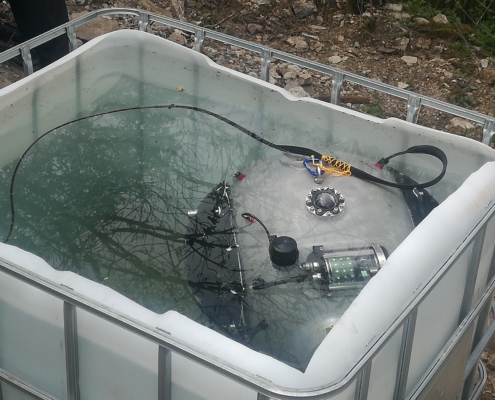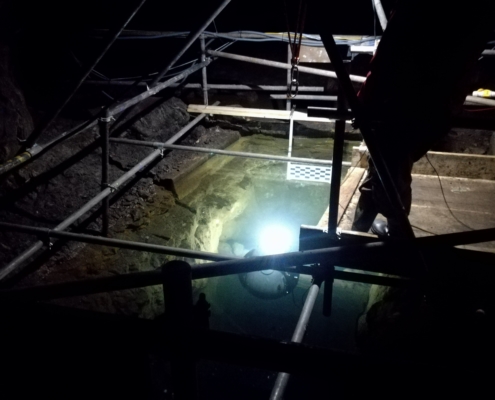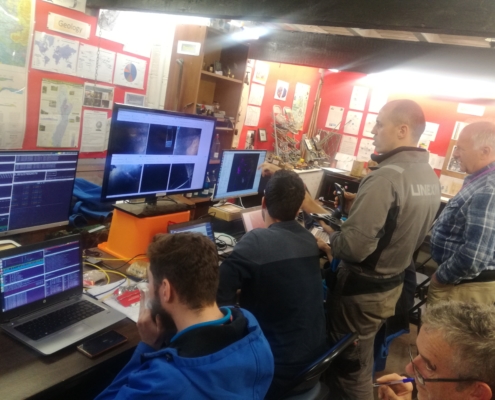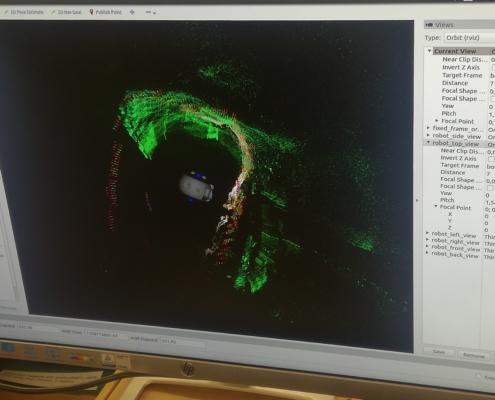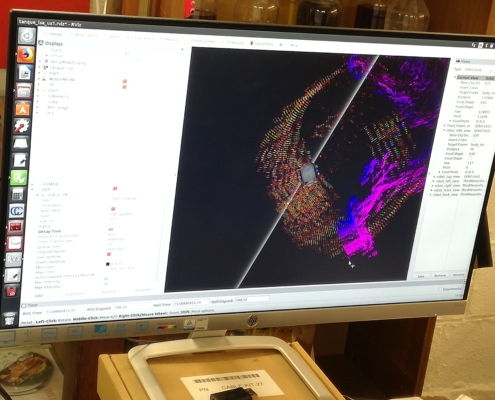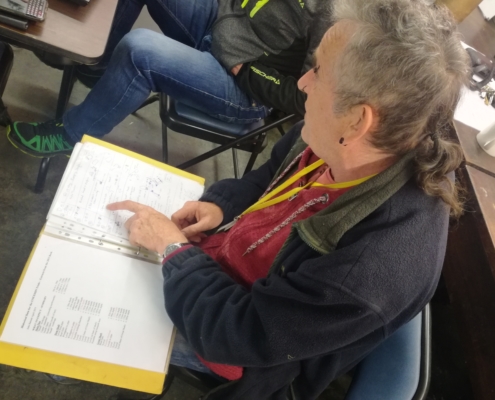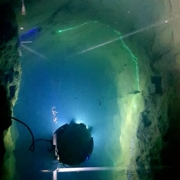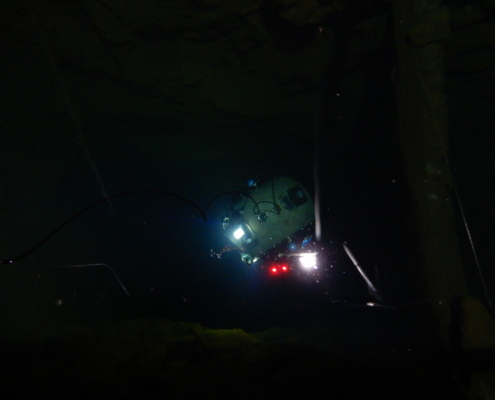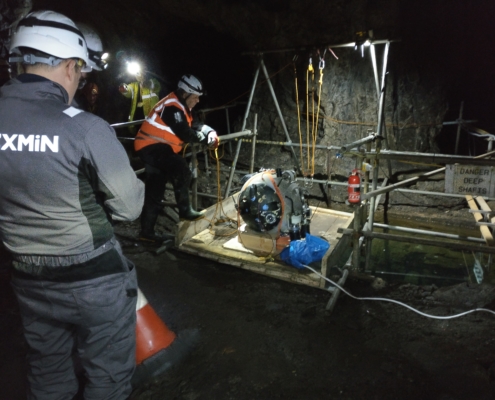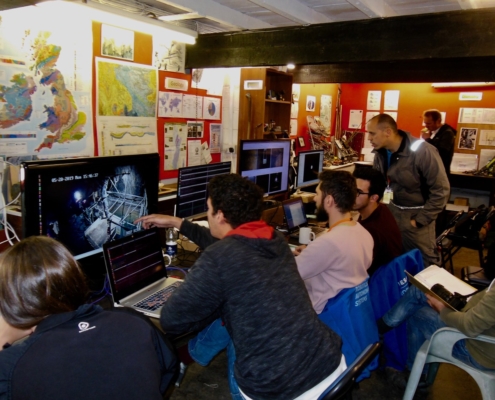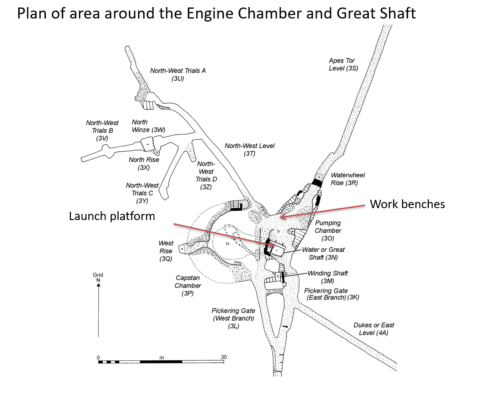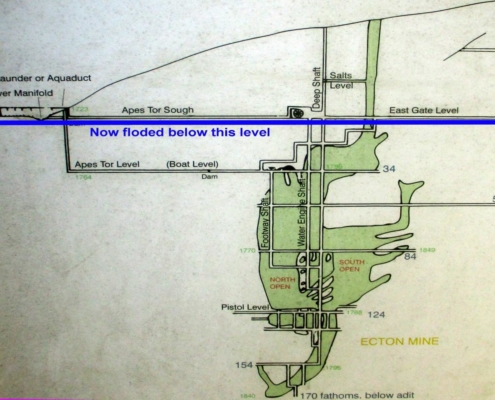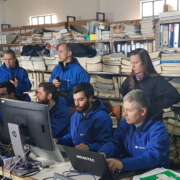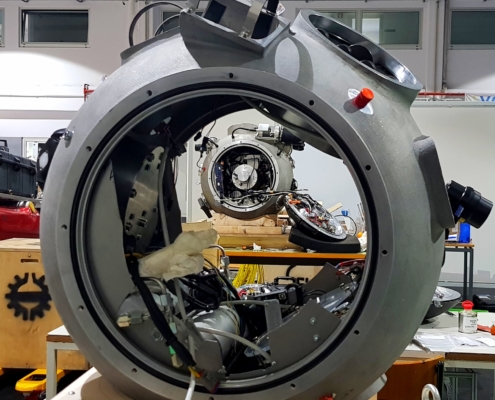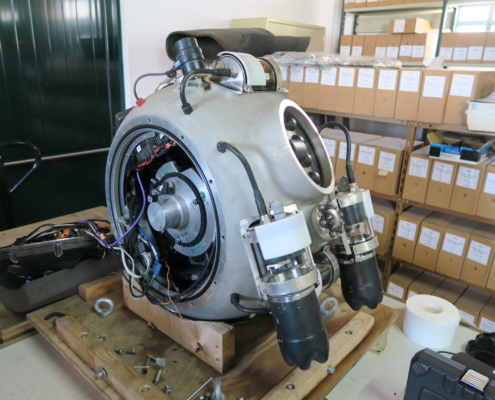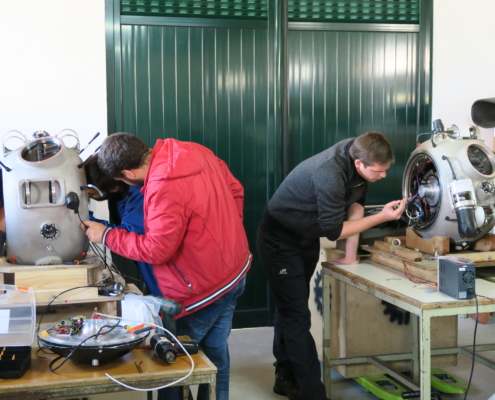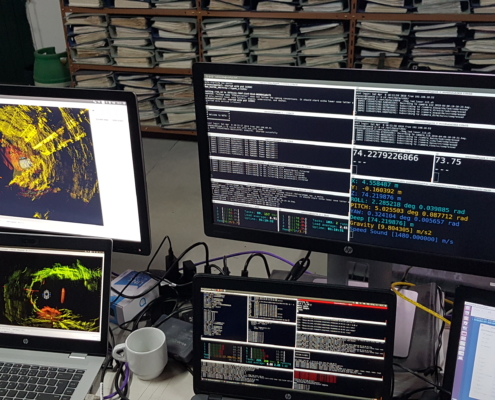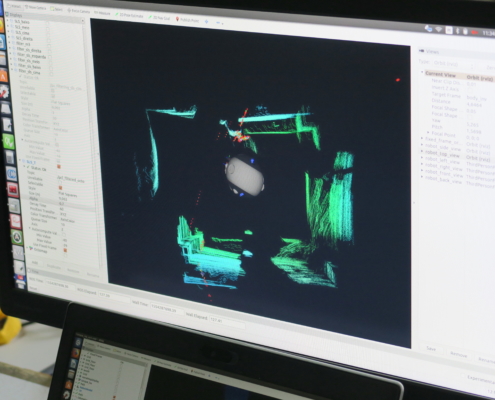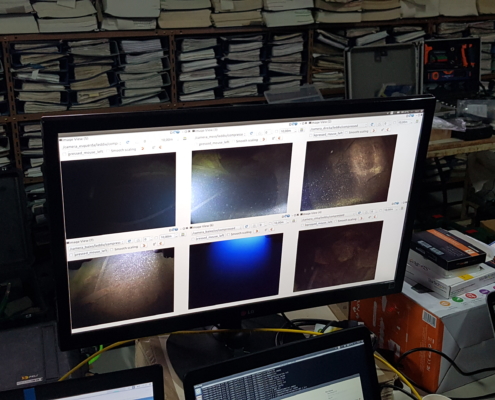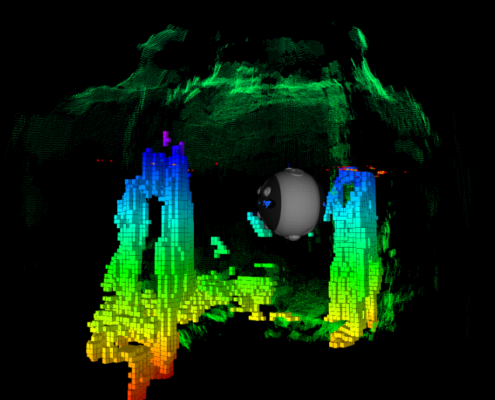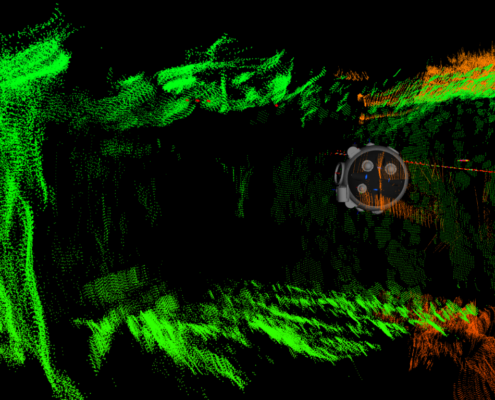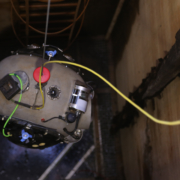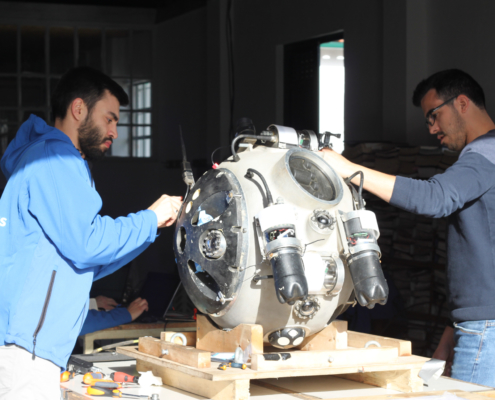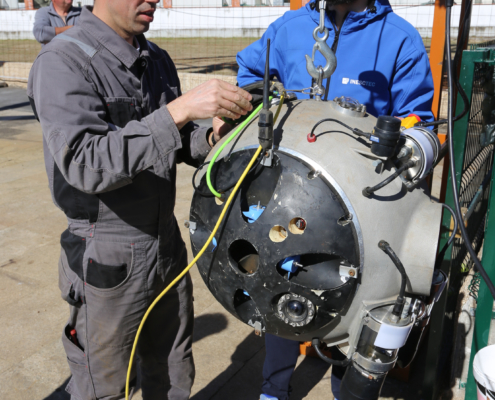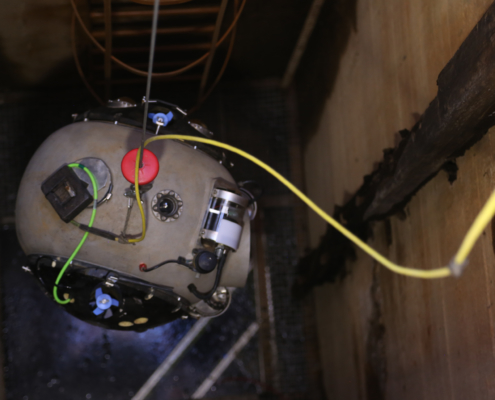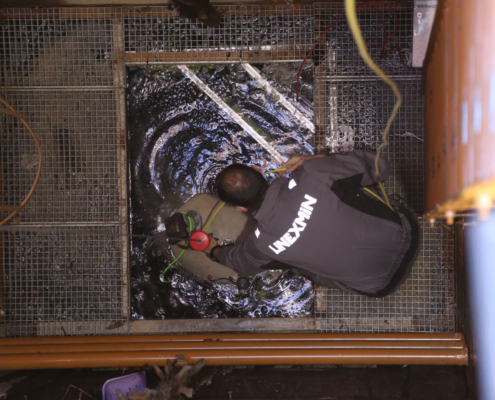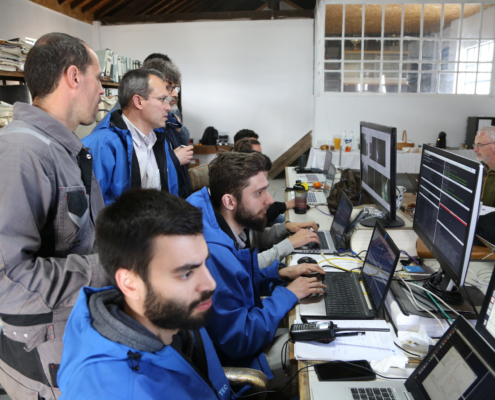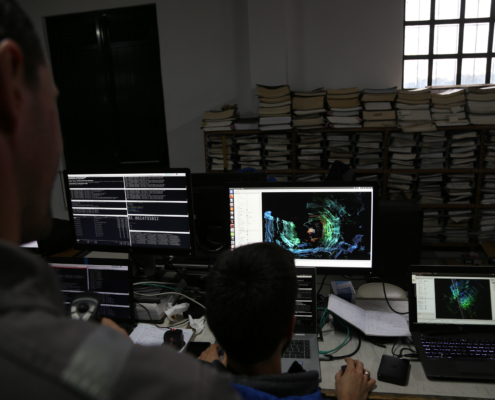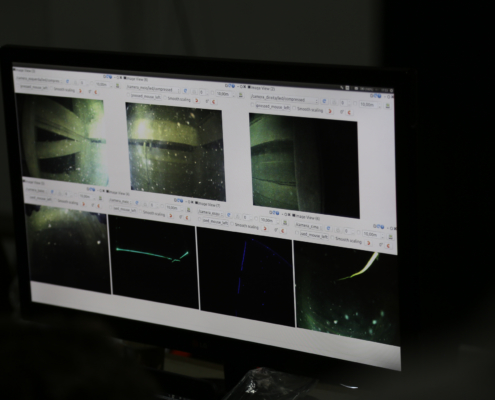Posts
Summary of the second week of field work at the Ecton mine, UK
/in Field trials, News/by Luis LopesThe UNEXMIN’s Ecton field mission that officially started on the 13th of May, will run until the 31st. After the exploration efforts made during the first week (from 13 to 19 May), that provided some interesting results on the flooded mine workings, such as shafts and galleries being mapped, the second week of trials is now surpassed. The most relevant aspects of this week were:
- 20th of May (Monday): The first dive of the second week was quite successful: UX-1 dived around to 92m without major problems. John Barnatt, EMET’s archeologist, managed to get information on parts of the mine that he thought did not even to exist! Also, past mining heritage, including wooden support structures were identified.
- 21st of May (Tuesday): One dive was made with the UX-1 robot during this day. A depth of 54m meters down the Great shaft was reached. Similarly to the past day, both geological and archeological items of relevance were identified with the help of images provided by the many UX-1’s cameras.
- 22nd of May (Wednesday): Day dedicated to adjustments and small repairs on the robots. Part of the UNEXMIN team had a guided visit to another mine near Ecton – the Clayton mine. Similarly to Ecton, Clayton mine was operated in the past and is now closed and partly flooded. Perhaps another site for the UNEXMIN exploratory technology?
- 23rd of May (Thursday): A simple test dive with the robots was performed to assure the operability of the robots after the past-day improvements and repairs.
- 24th of May (Friday): The UX-1a robot once again dived within the Main shaft up to around 94m. Around the mark of 52m depth, the team of UNEXMIN geologists managed to visually identify some interesting mineralogy, quite different from the surroundings – a patch of green minerals (thought to be of malachite). Further identification is only possible with the use of the multispectral camera, which the UX-1 robot will do.
- 25th of May (Saturday): First dive with the UX-1b robot during the second week. Due to this reason and for guaranteed security of operations the robot only dived up to the 59m mark. Once again the patch of green minerals was seen on camera. Other geological structures such as stockworks were also identified by the geologists’ team.
- 26th of May (Sunday): During the last dive of the second week the UX-1b robot managed to dive until the deepest point reached since the beginning of trials at the Ecton mine – 125m! The robot went down through the Main shaft, passed by two main intersections with other mining structures and managed to navigate around an area where an intersection between two shafts is seen. On the way up, the UX-1 robot collected some water samples, that will be later analysed in laboratory to learn more about the water chemistry at the flooded shaft.
After a successful second week, where the team met its major objectives – depths reached, areas mapped, discoveries made -, UNEXMIN is now proceeding with its last days in the UK. The aim is to reach even deeper and explore more flooded tunnels and galleries in a mine that has not been seen for the last 160 years… until UX-1 arrived!
Follow @UNEXMIN on our social media channels to keep up with the most recent news on the Ecton field trials: Facebook, Twitter and LinkedIn.
Summary of the first week of field work at the Ecton mine, UK
/in Field trials, News/by Luis LopesThe UNEXMIN team is in the UK, at the Ecton mines, to once again test its innovative exploration technology in real life conditions, after the field tests at Kaatiala, Idrija and Urgeiriça mines. The final aim of this trial is to map the most important flooded sections of the underground mine, at the same time as the team improves the operability of the surveying process. The first week on the field with the UX-1 robot was as follows:
- 13th of May (Monday): The first week of trials officially started on Monday, after a week of preliminary setups. The UNEXMIN team did some basic workings on both UX-1a and UX-1b robots. This was needed in order to have the robots ready for diving. All instruments and components of the robot were checked and repaired where needed.
- 14th to 16th of May (Tuesday to Thursday): Doing work on both the UX-1 robots, the control cabin with setting up connections between this and the work station inside the mine. Due to unexpected conditions, work got generally delayed, and the first official dive with the UX-1 robot only happened on Friday. Durind these days, the team strenghtened the operability of the robot, even without dives.
- 17th of May (Friday): The first dive with UX-1 was then done on this day. During this dive, the robot went up to a depth of 60m, through the Pumping shaft (also know as Great shaft). This was a highly successful dive: a lot of previously unrecorded geology and archeology was gathered from UX-1’s instrumentation. The UNEXMIN team found a big, interesting revelation at 58m: a very wide opening was identified, from which, EMET’s archeologist John Barnatt, believes to be a branch of the main mineral pipe – unexpected in that position.
- 18th of May (Saturday): Similarly to the Friday, the UX-1 robot descended until the 60m mark through the same shaft. This time, the main purpose was to test the robot capabilities such as movement, control and rapid descent. Most of the dive was achieved “nose down”, where the UX-1 robot moves with its front pointing downwards in a very challenging way.
- Sunday 19th (Sunday): Day-off dedicated to sighseeing around the Peak District. This area is known for its lead deposits in counterpart with Ecton, which is known for its copper deposits, quite unique in this geological area.
Follow @UNEXMIN on our social media channels to keep up with the most recent news on the Ecton field trials: Facebook, Twitter and LinkedIn.
Second week of field work and major achievements at the Urgeiriça mine, Portugal
/in Developments, Field trials, News/by Luis LopesThe second half of the UNEXMIN’s field tests at the Urgeiriça underground flooded mine happened between the 1st and 7th of April, in Portugal, following the first two weeks of trials. For this second half of testing the team brought together both UX-1a and UX-1b to be tested in the waters of Urgeiriça. The highlights of this second half are:
- 1st of April (Monday): The UNEXMIN team tested the UX-1a in the Lab test tank in the morning and packed both UX-1a and UX-1b robots and the needed equipment for the Urgeiriça trials in the afternoon. The team arrived at the Urgeiriça mine site around 20h00.
- 2nd of April (Tuesday): The equipment was unpacked, the control room set-up and fiber optic communication with the shaft switch was tested. A field laboratory was also installed with all the required equipment in the control room, to assemble the UX-1 robots. In the afternoon, after all the basic tests/checks, the first dive was done with UX-1a. The main goal of this first dive was to map the vertical shaft with the robot facing the shaft itself, i.e., pitch down and pitch up. The maximum depth reached was 27m below the surface. Up to 20 meters deep the visibility was disturbed by the bubbles accumulated in the dome glasses of the cameras, which also disturbed the DVL and, consequently, the robot’s navigation. After 20m depth the visibility was good and the water clear.
- 3rd of April (Wednesday): The robot’s weight was calibrated in water to have a better Roll when pitching Up and Down. A mapping dive was made on the central shaft up to 46.5m where all SLSs (Structured Light Systems) were tested with the robot in pitch down and pitch up positions. The construction of real-time maps using the “octomap” technique was also tested successfully.
- 4th of April (Thursday): Open day to media and the general population at the trial site. Two national television stations (SIC, RTP) were present at the testing site. Norbert Zajzon (project coordinator; UNIM) and Alfredo Martins (INESC TEC) were interviewed by the television stations, which showed a lot of interest in the project.
During this day two dives were made, one in the morning and the other in the afternoon. The morning dive was to the first level (22m below the surface) that served as a demonstration to the media and also to validate the mapping with all the sensors. At the entrance of this level a possible uranium rock was visually identified by Janos Horvath (Geo-Montan), proving the usefulness of the UNEXMIN technology to geologists and alike. In the afternoon dive, the depth of 46.2m was reached. In the ascent to the surface there was a power failure in the robot. UX-1 was successfully recovered due to the safe mechanisms applied by the UNEXMIN team, such as the umbilical cord that links the robot to a power source. - 5th of April (Friday): “Exame informática”, a Portuguese technology focused magazine, made a one-day mission coverage of the UNEXMIN project. Two dives were performed, one in the morning and the other by the end of the day. The morning dive served to validate the correct functioning of the robot after the corrections of the problems from the previous day. The end-of-the-day dive served to validate the real-time mapping with SLS and Multibeam sensors, where the robot reached a depth of 58m. After the dive, and taking advantage of the fact that there was no sunlight, the team tested the LEDs’ UV-light with the minerals example, in order to calibrate the triggering time of the LEDs and their intensity to facilitate identification of minerals.
- 6th of April (Saturday): Two dives were performed, one up to 68m in the morning and another until the maximum depth reached, as of today, by the UX-1 robot: 106.5m! In the afternoon dive it was possible to obtain multispectral images in the 3rd level of rocky areas of interest. It was also possible to enter the gallery up to 9 meters and build the 3D map of it.
- 7th of April (Sunday): Packing and cleaning the site.
The field trials at the Urgeiriça flooded mine site were completed successfully with a great effort made by the UNEXMIN’s technical teams. Together with the help from the local stakeholders (EDM), the elapsing of the trial – on both the first and second halves – went very well. From this long but fruitful trial, the major take-outs are:
- The first two robots, UX-1a and UX-1b, were for the fist time working together on the field
- The biggest dive with a UX-1 robot was reached – 106.5m
- Scientific instrumentation was tested successfully – UV light, water sampler and others
- Navigation and movement within the application environment saw improvements – moving pitch down and pitch up inside the shafts
- Good coverage and dissemination of the UNEXMIN project’s activities to the local and national media in Portugal.
The UNEXMIN partners will now continue with the project’s development – which includes the development of the third robot, UX-1c – and make preparations for the next field trial in the Ecton mine, UK.
First week of field work at the Urgeiriça mine, Portugal
/in Field trials, News/by Luis LopesThe UNEXMIN team is currently testing its innovative exploration solution in Portugal, at the closed and flooded underground Urgeiriça mine. The Urgeiriça field trials are divided in two sets of testing, with a period of laboratory work in between at INESC TEC. The first part has just ended and the first results are coming in:
- 6th of March (Wednesday): The UNEXMIN team tested and packed the UX-1a robot and the needed equipment for the Urgeirica trials and travelled to the test site from Porto.
- 7th of March (Thursday): The setup of the control room, launch site and the necessary communications went quickly as the Urgeiriça mine site had the appropriate infrastructures already in place. The first dive of the UX-1a robot was done on the afternoon of this same day, right after the team had received the necessary safety instructions from the Health and Safety body. The water table was ca. 7 m below the surface level in the shaft where the robot dived.
- 9th of March (Saturday): The robot went down to 54m water depth (2nd level, 60m below surface level).
- 11th (Monday) to 14th of March (Thursday): The UX-1a robot explored the shaft down to 104m water depth (4th level, 110 m bsl.). The entrances of the first four levels were mapped (1st level is at 30 m, 2nd at60 m, 3rd at 85 m and the 4th at 110m, below sea level).
- The entrance chamber of the 1st level was partially collapsed, with lots of rocks, wood logs and metal pipes, so only a few metres were investigated not to risk the robot. The 2nd level is collapsed after few metres so it could not be searched. The 3rd level was in good condition, so this level was used in multiple test dives to test and develop the instruments. The visibility of the water in the mine was very good, and even with the sediment disturbed by the robot it sank quickly as it was in the sand-coarse size fraction. The whole surface of the shaft was covered with wood, except the horizontal levels. The granite wall with black veins at the entrance of the 3rd level was recorded by the multispectral camera also. The γ-ray counter of the UX-1b was separately tested down to the 2nd level, lowered down in a cable parallel to another developed underwater γ-ray counter for cross validation.
- 15th of March (Friday): The last dive was performed in the afternoon. After that, the control room and the site were partially disassembled until the second part of the field trials, from 1st of April onwards. The UNEXMIN team travelled back to Porto to INESC TEC’s laboratory and packed out the field equipment to continue testing and instrument calibration within the testing pool.
The first part of the Urgeiriça field trials went as expected: the UX-1a robot was further tested; instruments were working correctly; the robot as a whole performed its functions and managed to explore, map and gather information on some of the flooded areas of the Urgeiriça mine. These data will help the team to develop 3D maps and other visualisation tools of interest.
Now it is time for the team to proceed with the development of the UX-1b robot. This second robot, that will carry some other scientific equiment than its counterpart UX-1a, will be tested on the field during the second phase of the Urgeiriça field trials. It will collect some different data that will complement data gathered by UX-1a.
Back to the lab and then to the field again!
—
Follow @UNEXMIN on our social media channels to keep up with the most recent news on the Urgeiriça field trials: Facebook, Twitter and LinkedIn.
Recently on UNEXMIN…
- UNEXUP at EGU2020: Sharing Geoscience Online 11th May 2020
- UNEXUP e-meeting on “risk mitigation measures” 4th May 2020
- Technical Requirements of UNEXUP 21st April 2020
- Consortium e-meeting – Technical Requirements and Commercialization plan 30th March 2020
- Our first Press Release has been published! 16th March 2020
I want to know about…


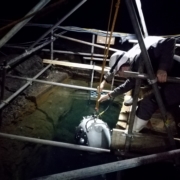 Edit Babinszki
Edit Babinszki